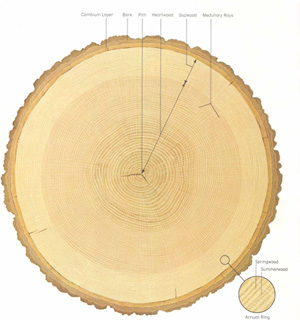© 2020 Gates Lumber Company. All rights reserved. Privacy Policy | Site Map | Website Design by S2N Design
These terms are misleading. The term “hardwood” has no bearing on the actual hardness of the wood. Hardwoods come from deciduous flowering broadleaved trees. Softwoods come from coniferous trees with needle like leaves. Most are evergreen, but a few are deciduous such as Larch. Some “hardwoods,” Aspen and Balsa for example, are much softer than some hard “softwoods” such as Yew and Larch.
The thickness of lumber is read in quarters of inches.
Four-quarters 4/4
Five-quarters 5/4
Six-quarters 6/4
Eight-quarters 8/4
Etc.
In rough lumber (also called nominal thickness or size) that has not been surfaced (planed smooth)
4/4 rough = 1″ board thickness
5/4 rough = 1-1/4″ board thickness
6/4 rough = 1-1/2″ board thickness
8/4 rough = 2″ board thickness
But surfaced lumber that has been planed smooth may vary slightly in thickness.
4/4 surfaced = 3/4″ to 13/16″
5/4 surfaced = 1″ to 1-1/8″
6/4 surfaced = 1-1/4″ to 1-3/8″
8/4 surfaced = 1-3/4″ etc.
Commercial Lumber sizes in 4/4 lumber are as follows
1 x 2 = 3/4″ x 1-1/2″
1 x 4 = 3/4″ x 3-1/2″
1 x 6 = 3/4″ x 5-1/2″
1 x 8 = 3/4″ x 7-1/4″
1 x 10 = 3/4″ x 9-1/4″
1 x 12 = 3/4″ x 11-1/4″
A Board Foot
1 foot square by 1 inch thick
or
144 cubic inches
Either multiply the length in feet times the thickness in inches times the width in inches and then divide by 12
Length’ x thickness” x width” / 12 =1 bf
or
Multiply the length in inches times the thickness in inches times the width in inches and then divide by 144
Length” x thickness” x width” / 144 = 1 bf


© 2020 Gates Lumber Company. All rights reserved. Privacy Policy | Site Map | Website Design by S2N Design